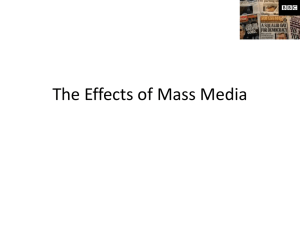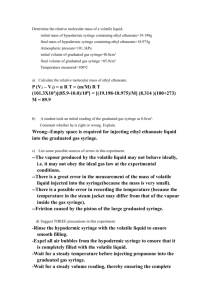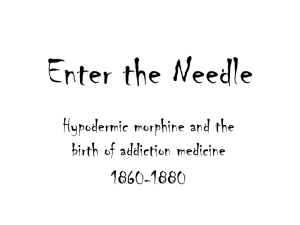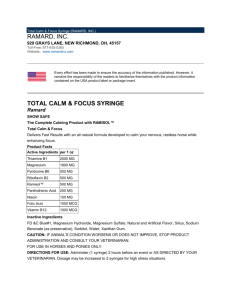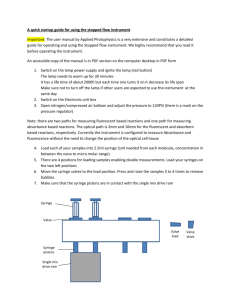The hypodermic syringe model is a theory of media
advertisement
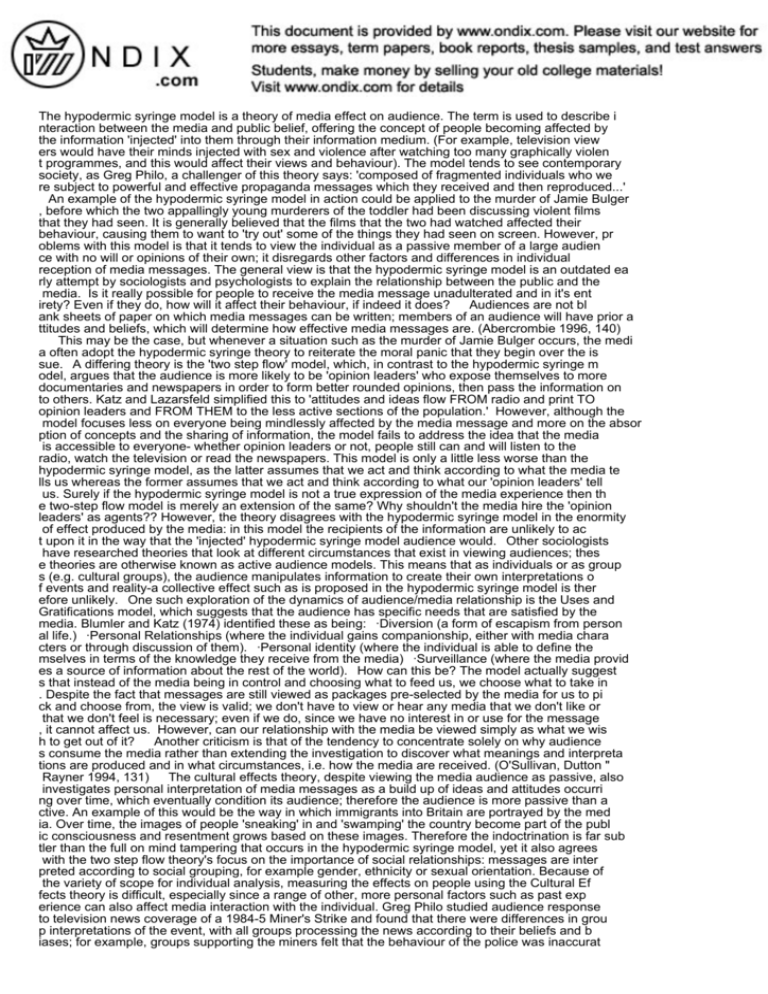
The hypodermic syringe model is a theory of media effect on audience. The term is used to describe i nteraction between the media and public belief, offering the concept of people becoming affected by the information 'injected' into them through their information medium. (For example, television view ers would have their minds injected with sex and violence after watching too many graphically violen t programmes, and this would affect their views and behaviour). The model tends to see contemporary society, as Greg Philo, a challenger of this theory says: 'composed of fragmented individuals who we re subject to powerful and effective propaganda messages which they received and then reproduced...' An example of the hypodermic syringe model in action could be applied to the murder of Jamie Bulger , before which the two appallingly young murderers of the toddler had been discussing violent films that they had seen. It is generally believed that the films that the two had watched affected their behaviour, causing them to want to 'try out' some of the things they had seen on screen. However, pr oblems with this model is that it tends to view the individual as a passive member of a large audien ce with no will or opinions of their own; it disregards other factors and differences in individual reception of media messages. The general view is that the hypodermic syringe model is an outdated ea rly attempt by sociologists and psychologists to explain the relationship between the public and the media. Is it really possible for people to receive the media message unadulterated and in it's ent irety? Even if they do, how will it affect their behaviour, if indeed it does? Audiences are not bl ank sheets of paper on which media messages can be written; members of an audience will have prior a ttitudes and beliefs, which will determine how effective media messages are. (Abercrombie 1996, 140) This may be the case, but whenever a situation such as the murder of Jamie Bulger occurs, the medi a often adopt the hypodermic syringe theory to reiterate the moral panic that they begin over the is sue. A differing theory is the 'two step flow' model, which, in contrast to the hypodermic syringe m odel, argues that the audience is more likely to be 'opinion leaders' who expose themselves to more documentaries and newspapers in order to form better rounded opinions, then pass the information on to others. Katz and Lazarsfeld simplified this to 'attitudes and ideas flow FROM radio and print TO opinion leaders and FROM THEM to the less active sections of the population.' However, although the model focuses less on everyone being mindlessly affected by the media message and more on the absor ption of concepts and the sharing of information, the model fails to address the idea that the media is accessible to everyone- whether opinion leaders or not, people still can and will listen to the radio, watch the television or read the newspapers. This model is only a little less worse than the hypodermic syringe model, as the latter assumes that we act and think according to what the media te lls us whereas the former assumes that we act and think according to what our 'opinion leaders' tell us. Surely if the hypodermic syringe model is not a true expression of the media experience then th e two-step flow model is merely an extension of the same? Why shouldn't the media hire the 'opinion leaders' as agents?? However, the theory disagrees with the hypodermic syringe model in the enormity of effect produced by the media: in this model the recipients of the information are unlikely to ac t upon it in the way that the 'injected' hypodermic syringe model audience would. Other sociologists have researched theories that look at different circumstances that exist in viewing audiences; thes e theories are otherwise known as active audience models. This means that as individuals or as group s (e.g. cultural groups), the audience manipulates information to create their own interpretations o f events and reality-a collective effect such as is proposed in the hypodermic syringe model is ther efore unlikely. One such exploration of the dynamics of audience/media relationship is the Uses and Gratifications model, which suggests that the audience has specific needs that are satisfied by the media. Blumler and Katz (1974) identified these as being: ·Diversion (a form of escapism from person al life.) ·Personal Relationships (where the individual gains companionship, either with media chara cters or through discussion of them). ·Personal identity (where the individual is able to define the mselves in terms of the knowledge they receive from the media) ·Surveillance (where the media provid es a source of information about the rest of the world). How can this be? The model actually suggest s that instead of the media being in control and choosing what to feed us, we choose what to take in . Despite the fact that messages are still viewed as packages pre-selected by the media for us to pi ck and choose from, the view is valid; we don't have to view or hear any media that we don't like or that we don't feel is necessary; even if we do, since we have no interest in or use for the message , it cannot affect us. However, can our relationship with the media be viewed simply as what we wis h to get out of it? Another criticism is that of the tendency to concentrate solely on why audience s consume the media rather than extending the investigation to discover what meanings and interpreta tions are produced and in what circumstances, i.e. how the media are received. (O'Sullivan, Dutton " Rayner 1994, 131) The cultural effects theory, despite viewing the media audience as passive, also investigates personal interpretation of media messages as a build up of ideas and attitudes occurri ng over time, which eventually condition its audience; therefore the audience is more passive than a ctive. An example of this would be the way in which immigrants into Britain are portrayed by the med ia. Over time, the images of people 'sneaking' in and 'swamping' the country become part of the publ ic consciousness and resentment grows based on these images. Therefore the indoctrination is far sub tler than the full on mind tampering that occurs in the hypodermic syringe model, yet it also agrees with the two step flow theory's focus on the importance of social relationships: messages are inter preted according to social grouping, for example gender, ethnicity or sexual orientation. Because of the variety of scope for individual analysis, measuring the effects on people using the Cultural Ef fects theory is difficult, especially since a range of other, more personal factors such as past exp erience can also affect media interaction with the individual. Greg Philo studied audience response to television news coverage of a 1984-5 Miner's Strike and found that there were differences in grou p interpretations of the event, with all groups processing the news according to their beliefs and b iases; for example, groups supporting the miners felt that the behaviour of the police was inaccurat ely reported whereas groups supporting the police felt that the behaviour of the miners was inaccura tely reported. Both groups, however, were able to objectively see the intention of the article, whic h was to portray the miners as violent. This model probably has more relevance to post-modern societ y than the hypodermic syringe model because it accepts that people question what they see and hear f rom the media, and they use their personal experiences to colour their interpretations of the meanin g of the media. In conclusion, the hypodermic syringe model cannot be considered to be an accurate r eflection of the postmodern societal relationship with the media: it has fatal flaws in its assumpti ons of the audience as mass and it's disregard for other factors such as social relationships and pe rsonal opinion. The other theories researched, although criticisms can be found for them, offer a vi ew of the media audience that is far more realistic. hypodermic syringe model theory media effec t audience term used describe interaction between media public belief offering concept people becomi ng affected information injected into them through their information medium example television viewe rs would have their minds injected with violence after watching many graphically violent programmes this would affect their views behaviour model tends contemporary society greg philo challenger this theory says composed fragmented individuals were subject powerful effective propaganda messages whic h they received then reproduced example hypodermic syringe model action could applied murder jamie b ulger before which appallingly young murderers toddler been discussing violent films that they seen generally believed that films that watched affected behaviour causing them want some things they see n screen however problems with this tends view individual passive member large audience with will op inions disregards other factors differences individual reception media messages general view hypoder mic syringe outdated early attempt sociologists psychologists explain relationship between public re ally possible people receive message unadulterated entirety even will affect behaviour indeed does a udiences blank sheets paper which messages written members audience will have prior attitudes belief s determine effective abercrombie case whenever situation such murder jamie bulger occurs often adop t theory reiterate moral panic begin over issue differing step flow contrast argues more likely opin ion leaders expose themselves more documentaries newspapers order form better rounded opinions then pass information others katz lazarsfeld simplified attitudes ideas flow from radio print opinion lea ders from them less active sections population however although focuses less everyone being mindless ly affected message more absorption concepts sharing fails address idea accessible everyone whether opinion leaders people still listen radio watch television read newspapers only little less worse th an latter assumes think according what tells whereas former assumes think according what tell surely true expression experience then step flow merely extension same shouldn hire agents however disagre es enormity effect produced recipients unlikely upon injected would other sociologists have research ed theories look different circumstances exist viewing audiences these theories otherwise known acti ve models means individuals groups cultural groups manipulates create interpretations events reality collective effect such proposed therefore unlikely such exploration dynamics relationship uses grat ifications suggests specific needs satisfied blumler katz identified these being diversion form esca pism from personal life personal relationships where individual gains companionship either character s through discussion personal identity where able define themselves terms knowledge receive surveill ance where provides source about rest world actually suggests instead being control choosing what fe ed choose take despite fact still viewed packages selected pick choose view valid hear like feel nec essary even since interest message cannot affect relationship viewed simply wish another criticism t endency concentrate solely audiences consume rather than extending investigation discover meanings i nterpretations produced circumstances received sullivan dutton rayner cultural effects despite viewi ng passive also investigates interpretation build ideas attitudes occurring over time eventually con dition therefore passive than active example immigrants into britain portrayed over time images snea king swamping country become part public consciousness resentment grows based these images therefore indoctrination subtler full mind tampering occurs also agrees step focus importance social relation ships interpreted according social grouping gender ethnicity sexual orientation because variety scop e analysis measuring effects using cultural effects difficult especially since range other factors p ast experience also interaction greg philo studied response television news coverage miner strike fo und there were differences group interpretations event groups processing news beliefs biases support ing miners felt police inaccurately reported whereas supporting police felt miners inaccurately repo rted both were able objectively intention article portray miners violent probably relevance post mod ern society because accepts question hear experiences colour meaning conclusion cannot considered ac curate reflection postmodern societal fatal flaws assumptions mass disregard factors social relation ships theories researched although criticisms found offer realisticEssay, essays, termpaper, term pa per, termpapers, term papers, book reports, study, college, thesis, dessertation, test answers, free research, book research, study help, download essay, download term papers
